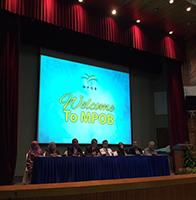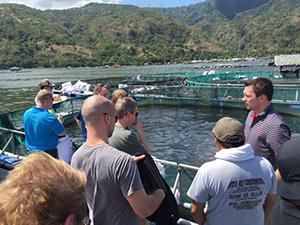The U.S. Grains Council (USGC) and the U.S. Meat Export Federation (USMEF) showcased the agricultural export markets of Malaysia and the Philippines to members of the Iowa Corn Leadership Enhancement and Development program, also known as I-LEAD, this week during a mission to the region.
The I-LEAD program is on its seventh class and is charged with the task of developing these young men and women into strong leaders for Iowa agriculture. This class consists of 18 participants who have a wide range of backgrounds ranging from full-time farming to genetic research to merchandising.
The Philippines and Malaysia provided a unique contrast for the class learning about the developing world. For example, the Philippines’ gross domestic product (GDP) per capita is less than $3,000 per year, whereas the wealthier Malaysia boasts a GDP per capita of almost $12,000.
In addition, both countries also present a difference in trading environments. Malaysia is a signatory to the mega-trade deal, the Trans-Pacific Partnership (TPP), where the Philippines has high tariffs and tariff rate quotas (TRQs) on many products, including corn.
“As a region, Southeast Asia is one of the largest corn importers in the world,� said USGC Regional Director for South and Southeast Asia Kevin Roepke. “If you include its huge soybean meal, DDGS (distiller’s dried grains with solubles), ethanol and meat/milk imports, the region’s importance to the state of Iowa is second to none.
“In addition to exposure to the region, this trip provided a firsthand look for the participants at the process behind agricultural trade, giving them invaluable experience that they can’t receive anywhere else.�
The team’s itinerary highlighted some of the challenges, opportunities and successes of agriculture in Southeast Asia. Participants got the opportunity to visit the historic Subic Bay, which is an important port for the importation of ethanol, as well as large feed millers, traders, aquaculture farms, a sugar mill/refinery, an ethanol plant and government officials, among many other activities.
“Members were surprised to hear that Malaysia’s main port, Kelang, is roughly as big as the United States’ two largest ports combined,� Roepke said. “They also learned about the juxtaposition of technologies that many corn farmers in the region use. These include planting by hand corn that contains biotech traits while documenting their records of planting on iPads.�
These firsthand experiences allowed mission participants to gain a greater understanding and appreciation of the global food system in which they live and work.
“(Participants) learned a lot (about Southeast Asia) and where the region is headed in the future,� wrote one I-LEAD member on a blog post about the mission.
Click here to learn more about the I-LEAD program. Click here to read more thoughts from mission participants about the journey, via the Iowa Corn Growers Association’s Corn Stalk blog.



